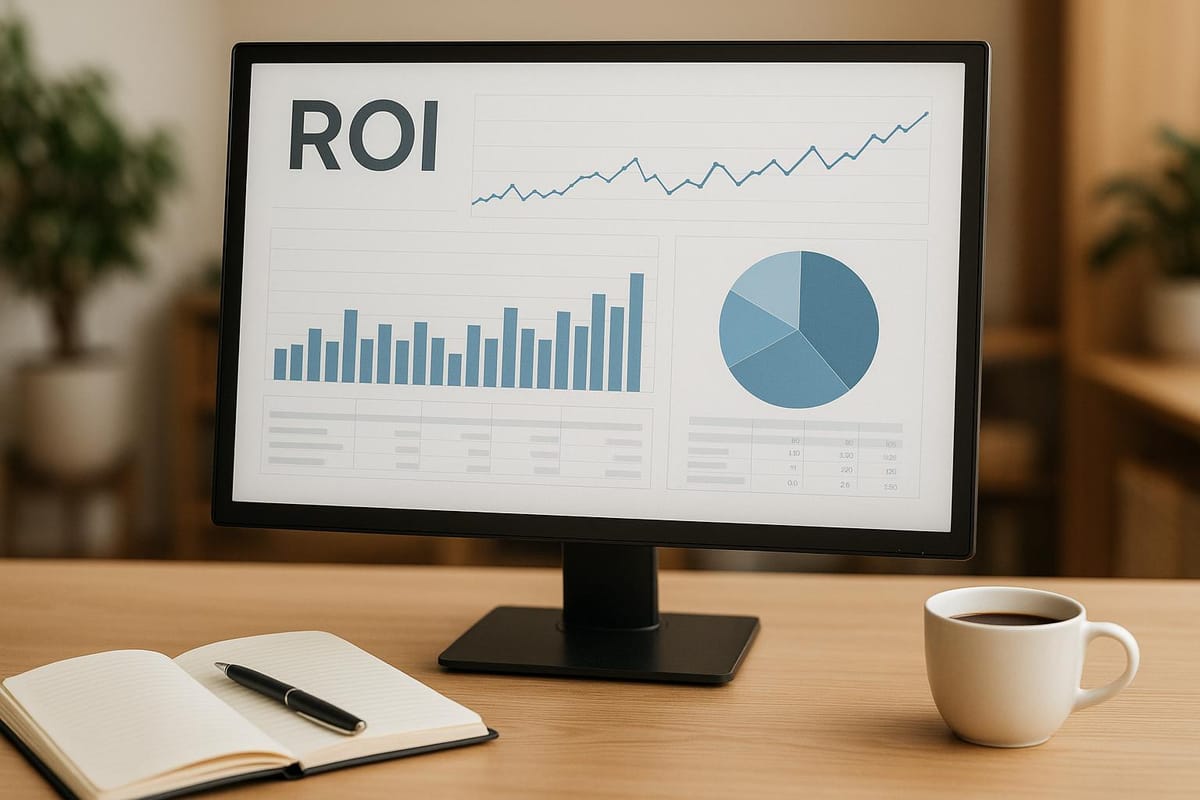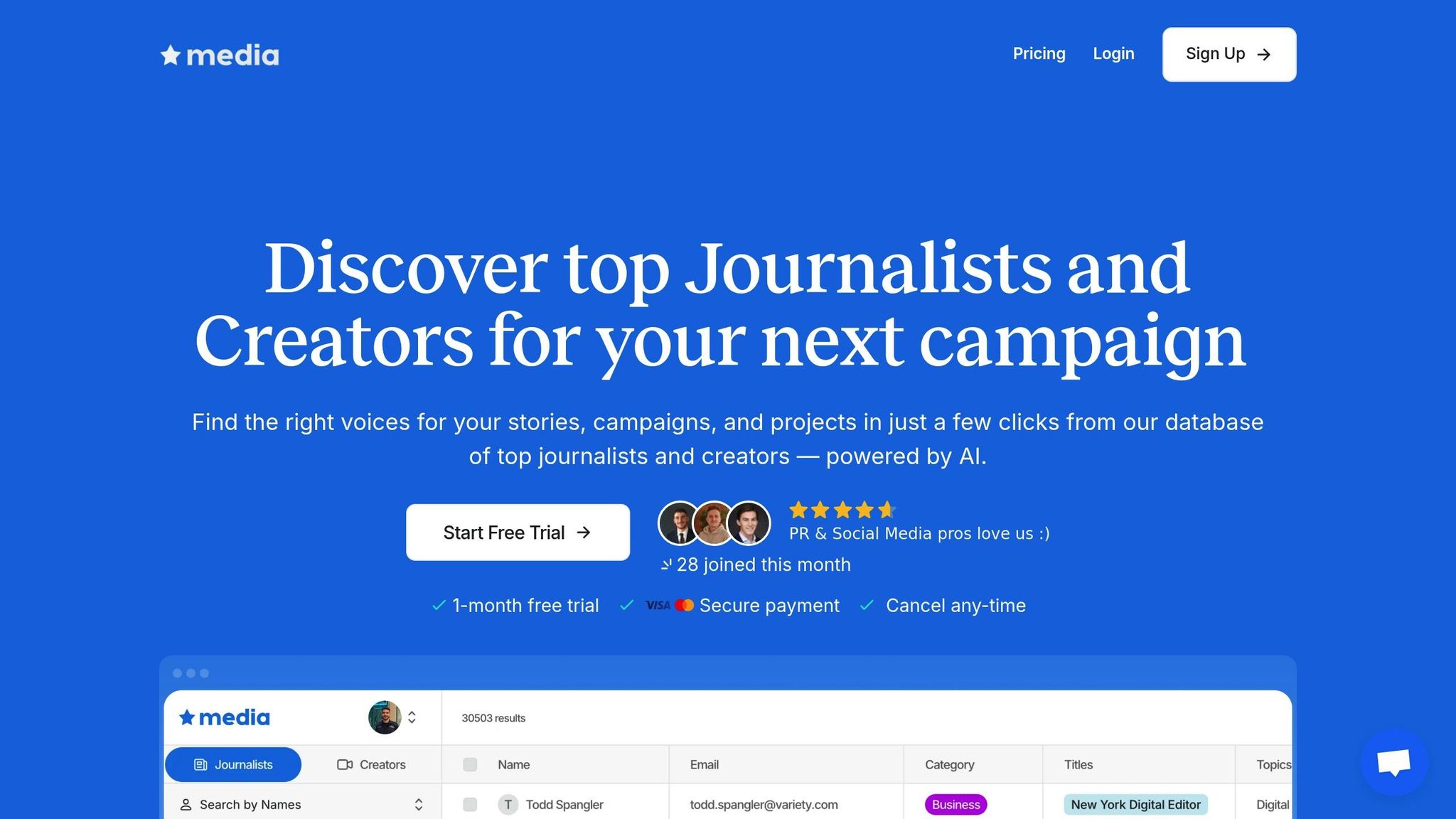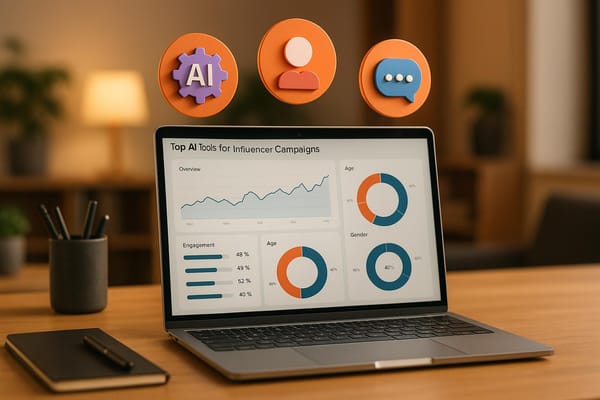How to Measure ROI in Creator Partnerships
Learn effective methods to measure ROI in creator partnerships, focusing on both financial and non-financial benefits for brands.

Measuring ROI in creator partnerships is about understanding the value your brand gains from influencer collaborations. This includes financial returns like sales and new customers, as well as non-financial benefits such as brand awareness and customer trust. With businesses earning an average of $6.50 for every $1 spent on influencer marketing, tracking ROI is essential for making smarter investments and optimizing campaigns.
To measure ROI effectively:
- Track all costs: Include creator fees, content production, product samples, internal resources, and agency fees.
- Attribute revenue: Use affiliate links, UTM parameters, or dedicated landing pages to link sales to specific creators.
- Analyze non-monetary value: Monitor engagement, reach, website traffic, and brand sentiment for a full picture.
- Use advanced tools: AI platforms like Media AI can streamline cost tracking, improve revenue attribution, and enhance efficiency.
Key Formula:
ROI = [(Revenue Generated – Total Spend) / Total Spend] × 100
For example, spending $10,000 and generating $25,000 in sales results in a 150% ROI.
How to Track Partnership Costs
Finding All Partnership Costs
Getting an accurate read on ROI starts with capturing every expense tied to your creator partnerships. Many brands make the mistake of focusing solely on creator fees, missing other, less obvious costs that can add up quickly.
Direct creator fees are the most straightforward expense. These vary widely depending on the platform and the creator's audience size. On Instagram, for instance, nano-influencers with 1,000–10,000 followers typically charge $10–$100 per post, while mega-influencers with 500,000+ followers can demand $10,000 or more. TikTok tends to be less expensive, with nano-influencers charging $5–$25 per post and mega-influencers starting at $2,500+ per post. YouTube, however, commands higher rates. Nano-influencers (10,000–50,000 followers) might charge $20–$200 per video, while mega-influencers with 1,000,000+ followers can ask for $20,000 or more per video.
Content production costs often catch brands off guard. These include expenses for professional photography, video editing, graphic design, and other creative assets. Even when creators handle their own production, brands might need additional content for their own channels or paid ads, which adds to the budget.
Product samples and gifting are another cost to consider. Beyond the wholesale cost of the products sent to creators, you’ll need to factor in packaging, shipping, and any customs fees for international partnerships. These costs can vary significantly depending on the product's value and shipping logistics.
Internal resource allocation reflects the time your team spends managing these partnerships. Tasks like creator outreach, campaign management, content reviews, and performance tracking all add up. For example, if a campaign manager earns $60,000 a year, you can calculate an hourly rate to understand the true personnel costs for these efforts.
Usage rights and exclusivity fees can significantly increase costs. If you want to extend content usage or secure exclusivity, you’ll likely need to pay additional fees beyond the creator's standard rate. These should be tracked separately since they often impact the long-term value of your campaigns.
Agency fees and platform costs are also part of the equation. If you’re working with an influencer marketing agency, be sure to account for their commission fees. Similarly, don’t overlook the recurring costs of influencer discovery platforms and management tools.
Once you’ve identified all potential costs, the next step is to implement a system to track them effectively.
Cost Tracking Methods
Tracking partnership costs effectively requires a structured approach from the start. Managing multiple creators, campaigns, and expense categories can get overwhelming, so having a clear system in place is essential.
- Spreadsheet-Based Tracking: Spreadsheets are a simple way to log expenses by category. Create columns for costs like creator fees, production expenses, product samples, shipping, internal time, and other miscellaneous items. Include details like campaign dates, creator names, deliverables, and payment statuses to keep everything organized without needing additional software.
- Financial Management Software: For larger-scale partnerships, tools like QuickBooks or FreshBooks can simplify expense tracking. These systems can automatically categorize costs, manage payment schedules, and generate detailed reports for specific campaigns or time periods. Integration with bank accounts and credit cards also reduces manual entry errors.
- Automated Payment Triggers: Using systems that automate payments once deliverables are approved can streamline record-keeping and cut down on administrative tasks, ensuring accuracy in payment tracking.
- Real-Time Expense Monitoring: Regularly reviewing your spending - say, on a weekly basis - can help you compare actual expenses to your budget. This allows for quick adjustments if costs start to exceed expectations mid-campaign.
- Centralized Documentation: Keep all partnership agreements, including rate negotiations, deliverables, and performance metrics, in one place. These records not only make current tracking easier but also provide valuable insights for planning future campaigns.
The key to effective cost tracking is staying consistent and maintaining thorough documentation. This ensures every dollar spent is accounted for, giving you a clear picture of your ROI.
Your 3 Step Formula To Achieve & Measure High Roi Influencer Partnerships
How to Attribute Revenue and Value
Once you've tracked all the costs tied to your creator partnerships, the next step is figuring out how to link specific revenue and value back to those collaborations. This process is crucial for making informed decisions about future investments.
Revenue Attribution Methods
The most straightforward way to evaluate the ROI of creator partnerships is by tracking direct revenue. Affiliate links are an essential tool for this. When creators share unique affiliate links, you can monitor every purchase tied to their promotions. Platforms like Amazon Associates, ShareASale, and Commission Junction simplify this process with detailed reports on clicks, conversions, and revenue generated by each creator.
For even greater accuracy, UTM parameters can be added to URLs. These codes (e.g., ?utm_source=instagram&utm_medium=creator&utm_campaign=spring2024) allow you to pinpoint which traffic sources convert in tools like Google Analytics. This method works particularly well for tracking website traffic driven by creators.
Using dedicated landing pages takes attribution to another level. By creating unique URLs for individual creators, you can track conversions and gain insights into visitor behavior. Metrics like bounce rates, time spent on the site, and product interest can help you understand how each creator's audience interacts with your brand.
Additionally, partner-sourced revenue includes leads brought in through referral forms or UTM links. It's important to measure both direct revenue and partner-influenced revenue to capture the complete impact of a creator’s efforts, including any delayed effects.
"B2B buyers are looking to experts outside of your organization so they can understand how to best use your product." – Bryn Jones, CEO and co-founder of PartnerStack
These methods focus on tracking direct sales, but they also set the stage for evaluating non-monetary benefits.
Measuring Non-Monetary Value
Revenue isn't the only metric that matters. To get a full picture of ROI, you also need to measure intangible benefits like brand awareness, engagement, and audience growth, which can be just as impactful for long-term success.
Engagement rates are a key indicator of how well a creator’s content resonates with their audience. Unlike follower counts, engagement reveals the depth of connection between the creator and their community. For example, in 2024, brands experienced a 20% increase in average inbound engagements, jumping from 70% in 2023 to 83%. Daily inbound engagements per post also rose by 17%, from 12 to 14.
Metrics like reach and impressions provide insight into your brand's exposure. While these numbers don't translate directly into sales, they play a vital role in building recognition. Engagements on platforms like Facebook and Instagram grew by 9% and 28%, respectively, in 2024, showing their continued relevance for visibility.
Social media benchmarks help you evaluate your campaign's performance compared to industry standards. They can guide you in identifying which creator partnerships are delivering the best results.
Website traffic and behavior metrics are another valuable tool. By tracking new visitors, session durations, and pages viewed from creator-driven traffic, you can gauge the broader impact of these partnerships - even if immediate conversions aren’t happening.
Lastly, social listening tools allow you to monitor brand sentiment and the volume of conversations around your campaigns. By tracking mentions, hashtags, and overall sentiment during different stages of a campaign, you can better understand its broader impact.
Advanced Attribution Models
When your campaigns involve multiple touchpoints, advanced attribution models can provide a clearer picture of how value is distributed across interactions. For complex customer journeys or campaigns featuring several creators, basic attribution methods might not capture the full story.
Multi-touch attribution models are particularly useful here, as they distribute credit across multiple interactions. Given that buyers often engage with a brand 6 to 8 times before making a purchase, these models offer a more nuanced view of how creator partnerships contribute to the overall journey.
- Linear attribution divides credit equally among all tracked interactions.
- Time-decay attribution gives more weight to recent interactions.
- Position-based attribution prioritizes the first and last touchpoints.
- Data-driven attribution (DDA) uses machine learning to assign credit based on the unique contribution of each touchpoint.
For instance, in 2022, HexClad saw a 156% revenue increase and a 34% reduction in customer acquisition costs year-over-year by adopting advanced attribution models. This approach improved their marketing efficiency ratio from 3.9 in 2021 to 5.5x in 2022.
The success of attribution efforts hinges on aligning the goals of your marketing, sales, and partnerships teams. As Lauren Turner, a Customer Marketing Expert, puts it:
"When you have teams working toward different goals, they won't be helping each other out. It becomes more difficult to determine which metrics are the most important."
How to Calculate and Analyze ROI
To understand the value of a campaign, you need to run the numbers. While the math itself is straightforward, interpreting the results calls for a deeper look at your goals and the broader market context.
ROI Formula for Creator Partnerships
Here’s the standard formula for calculating ROI in creator partnerships:
ROI = [(Revenue Generated – Total Spend) / Total Spend] × 100
This formula gives you the percentage return on your investment. For example, if you spent $10,000 on a creator campaign and it brought in $25,000 in tracked sales, your ROI would be:
ROI = [($25,000 – $10,000) / $10,000] × 100 = 150%
That means for every dollar you spent, you earned $1.50 in profit. Keep in mind that average returns can vary significantly depending on the specifics of your campaign.
When calculating ROI, it’s important to use a timeframe that aligns with your campaign goals. For campaigns where conversions happen over time, extend your tracking period to capture the full impact. And don’t forget, qualitative benefits - like increased brand awareness - need to be assessed separately.
Once you’ve crunched the numbers, the next step is to analyze the results to refine your approach.
How to Interpret ROI Results
The meaning of your ROI depends on your campaign objectives and industry benchmarks. For example, a 150% ROI might be fantastic for a brand awareness campaign but could fall short for a direct-response campaign focused on immediate sales.
An ROI above 0% means your campaign generated net value. But what’s considered a “good” ROI? That depends on the type of campaign. For awareness-driven initiatives, even a 50% ROI might be acceptable if it supports long-term brand growth. On the other hand, performance campaigns often aim for higher targets, such as 200% or more.
Even a negative ROI can hold value. For instance, if your goal was to boost brand awareness and the campaign achieved strong reach and engagement, the long-term benefits might outweigh the short-term losses.
When analyzing results, always compare them to your initial objectives and industry standards. A survey found that 89% of marketers say influencer campaign ROI matches or surpasses other marketing channels. This highlights the potential value of well-planned creator partnerships.
To get the most out of your ROI analysis, break it down by variables like creator, platform, content type, and audience segment. This approach helps you pinpoint which elements drove success and where improvements are needed. For example, if one creator outperformed others, you might focus more on similar partnerships moving forward.
Long-term value is another critical factor. Nearly half of consumers (49%) make purchases at least once a month as a result of influencer posts. Metrics like customer lifetime value can help you understand the sustained impact of your campaigns.
If your ROI isn’t meeting expectations, use the data to guide your next steps. Low engagement could mean the creator’s audience doesn’t align with your brand, while high engagement but low conversions might point to pricing or product positioning issues. As marketing expert Neal Schaffer notes:
"The brands that win with influencers are those that treat them as partners, not billboards, and that means measuring what truly matters".
Ultimately, calculating ROI isn’t just about arriving at a single number - it’s about building a full picture. By combining the hard numbers with qualitative insights, you’ll be better equipped to make smarter decisions about your future creator partnerships.
Using Media AI for ROI Measurement

Expanding on the importance of detailed cost and revenue metrics, Media AI provides tools that simplify and refine these processes. By integrating cost tracking, revenue attribution, and performance analysis into one streamlined system, it saves time and improves accuracy.
How Media AI Simplifies Cost Tracking
Media AI replaces scattered spreadsheets with a centralized database of over 30,000 creators, making it easier to track fees, production costs, product seeding, and travel expenses. Its AI-powered filters help differentiate between creator types and uncover hidden costs, leading to a 25% improvement in ROI compared to manual methods.
These filters allow you to sort expenses by categories like micro and macro influencer fees, content licensing, or travel reimbursements. This structured approach not only highlights spending patterns but also ensures no costs - such as outreach or final deliverables - are overlooked. By capturing every expense, you lay the groundwork for more accurate ROI calculations.
Using Media AI for Revenue Attribution
Media AI enhances revenue attribution with advanced tools like audience fit algorithms, performance forecasting, and dynamic look-alikes. These features help refine creator selection and provide a more comprehensive view of the customer journey, going beyond basic last-click attribution.
One standout feature is the platform's ability to forecast performance. It identifies creators who surpass RoAS (Return on Ad Spend) benchmarks and flags them within 24 hours of a campaign’s completion. This quick turnaround allows you to scale successful partnerships and halt underperforming ones, maximizing campaign ROI.
A great example is XXL Nutrition, which used AI-driven attribution in a test campaign with eight Dutch fitness creators on TikTok and Instagram. With a $4,000 budget, three creators achieved over 2.8× RoAS, reducing the cost per acquisition by 34% compared to standard ads. By scaling these partnerships into Germany, they achieved a 38% year-over-year revenue increase while keeping new customer acquisition costs within 5% of the initial test phase.
These insights also contribute to smoother and more efficient workflows.
Improving Workflow Efficiency with Media AI
Media AI doesn’t just clarify revenue - it transforms operational efficiency. Tasks that typically require 3–5 full-time employees can now be handled by just 0.5–2 employees using AI. This shift allows your team to focus on strategic and creative work instead of routine data entry and analysis.
The platform’s export and reporting tools integrate seamlessly with analytics systems and CRMs, enabling you to pull creator data, performance metrics, and costs directly into your existing workflows. This eliminates manual data transfers, reducing error rates to under 0.5%, compared to 2–5% with manual methods. Plus, insights are delivered in minutes rather than weeks.
Real-time feedback is another game-changer. Media AI enables immediate campaign adjustments, scaling campaigns 20–40% more efficiently than manual methods. While human teams may manage 10–20 creator partnerships at once, Media AI can handle hundreds or even thousands across multiple platforms with precision.
As the system learns from your data, its predictions become increasingly accurate - up to 20% more precise than traditional forecasting. Companies leveraging AI marketing report a 10–20% boost in cost savings and efficiency. These improvements stem from reduced manual work, faster decision-making, and better targeting, ensuring that every part of your ROI measurement process runs as smoothly as possible.
Conclusion: Optimizing Creator Partnership ROI
By meticulously tracking costs and connecting revenue directly to influencer efforts, you can build a reliable framework for measuring ROI. This approach takes influencer marketing from being a guessing game to becoming a predictable growth strategy.
Start by defining clear, measurable goals and carefully tracking all costs associated with partnerships - this includes creator fees, outreach, licensing, and any hidden expenses. Next, focus on revenue attribution by using tools like UTM parameters, unique promo codes, and tracked links to tie influencer activity directly to conversions. Consistently calculating ROI and analyzing the results will help you identify what delivers real value.
"ROI analysis isn't optional. It's the only way to know if you're actually growing or just getting likes." - Jessica Torres, CMO, DTC Skincare Brand
AI-powered tools like Media AI are revolutionizing ROI measurement for brands. Instead of relying on time-intensive spreadsheets and manual processes that might require 3–5 full-time employees, companies can now manage the same workload with just 0.5–2 employees. These platforms also cut error rates from 2–5% to under 0.5%. By delivering insights in minutes rather than weeks and offering predictions up to 20% more accurate than traditional methods, brands gain a competitive edge. This efficiency not only saves time but also strengthens long-term strategies.
The numbers speak for themselves: 89% of marketers say influencer campaign ROI matches or surpasses other marketing channels. Data-driven approaches have helped companies improve marketing efficiency by up to 30%. For instance, OLIPOP achieved a 982% return on ad spend by automating creator discovery and performance tracking. Similarly, Revolve’s emphasis on long-term partnerships with creators played a key role in their $212 million IPO success.
Measuring ROI isn’t a one-and-done task - it’s an ongoing process. Regular analysis allows you to pinpoint top-performing creators, refine content formats, and prove value to stakeholders. With nearly half of consumers making monthly purchases influenced by creator posts, and the influencer marketing industry projected to hit $33 billion by 2025, brands that prioritize ROI measurement are poised to seize the biggest opportunities.
From tracking costs to advanced revenue attribution, every step strengthens your strategy for long-term growth. Ultimately, thriving in creator partnerships means aligning performance with metrics that directly impact your bottom line. Whether it’s cost per acquisition, return on ad spend, or lifetime customer value, the brands that consistently measure, analyze, and refine their approach are setting themselves up for lasting success in the creator-driven economy.
FAQs
How can brands measure non-monetary benefits like brand awareness and customer trust in creator partnerships?
Measuring non-monetary outcomes like brand awareness and customer trust in creator partnerships involves a mix of data-driven analysis and audience insights. For brand awareness, keep an eye on metrics such as social media engagement rates, branded search activity, share of voice across platforms, and website traffic patterns. These indicators help reveal how effectively your brand is connecting with its audience.
When it comes to assessing customer trust, tools like customer surveys, focus groups, and sentiment analysis are invaluable. They offer a window into how people perceive your brand. Additionally, paying attention to online reviews and comments can uncover key feedback about trust and credibility. By piecing together these data points, you can gain a clearer picture of how your creator partnerships influence your brand's reputation.
What should I consider when tracking costs for creator partnerships?
To keep tabs on costs for creator partnerships, make sure you account for every campaign-related expense, such as:
- Direct costs: These include payments to creators, content production expenses, platform fees, and any agency charges.
- Indirect costs: Think about the time your team spends, resource usage, and any extra overhead.
Organize your records carefully and categorize expenses to make ROI calculations straightforward. Tools like Media AI can simplify the process, helping you manage partnerships efficiently and concentrate on the outcomes.
How can advanced attribution models help measure ROI in creator partnerships more effectively?
Advanced attribution models give you a clearer picture of ROI when working with creators by breaking down how different touchpoints lead to conversions. They enable detailed revenue tracking across various channels, helping you pinpoint which creators and strategies deliver the best results.
With this information, marketers can better allocate resources, prioritize top-performing creators, and cut back on wasteful spending. The result? More accurate ROI tracking and smarter choices for upcoming campaigns.





